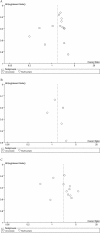Wilms' tumor 1 (WT1) expression and prognosis in solid cancer patients: a systematic review and meta-analysis
- PMID: 25748047
- PMCID: PMC4352850
- DOI: 10.1038/srep08924
Wilms' tumor 1 (WT1) expression and prognosis in solid cancer patients: a systematic review and meta-analysis
Abstract
Though proposed as a promising target antigen for cancer immunotherapy, the prognostic value of Wilms' tumor 1 (WT1) in solid tumors remains inconclusive. Here, we report a systematic review and meta-analysis of the association between WT1 expression and prognosis in solid tumors. PubMed, Web of Science and Google Scholar were searched to identify studies exploring the impact of WT1 on clinical outcomes, including overall survival (OS), disease-specific survival (DSS), disease-free survival (DFS), relapse/recurrence-free survival (RFS) or progression-free survival (PFS), in solid cancer patients. Hazard ratio (HR) and 95% confidence interval (CI) were applied to assess the strength of these associations. Finally, a total of 29 eligible studies with 4090 patients were identified for qualitative analysis, and 22 studies with 3620 patients were enrolled for quantitative synthesis. Overall, positive expression of WT1 was significantly associated with worse OS (metaHR = 1.48, 95% CI = 1.11-1.97) and DFS/RFS/PFS (metaHR = 2.14, 95% CI = 1.42-3.21). Subgroup analyses showed that WT1 positive expression could independently predict unfavorable DFS/RFS/PFS (metaHR = 1.86, 95%CI = 1.04-3.35). In summary, our study suggests that WT1 may be a potential marker to predict DFS/RFS/PFS in solid tumor patients. Further studies are needed to confirm the role of WT1 expression in clinical practice.
Figures





Similar articles
-
Wilms' tumor 1 (WT1) as a prognosis factor in gynecological cancers: A meta-analysis.Medicine (Baltimore). 2018 Jul;97(28):e11485. doi: 10.1097/MD.0000000000011485. Medicine (Baltimore). 2018. PMID: 29995811 Free PMC article.
-
Treatment options for progression or recurrence of glioblastoma: a network meta-analysis.Cochrane Database Syst Rev. 2021 May 4;5(1):CD013579. doi: 10.1002/14651858.CD013579.pub2. Cochrane Database Syst Rev. 2021. PMID: 34559423 Free PMC article.
-
Optimisation of chemotherapy and radiotherapy for untreated Hodgkin lymphoma patients with respect to second malignant neoplasms, overall and progression-free survival: individual participant data analysis.Cochrane Database Syst Rev. 2017 Sep 13;9(9):CD008814. doi: 10.1002/14651858.CD008814.pub2. Cochrane Database Syst Rev. 2017. PMID: 28901021 Free PMC article.
-
Prognostic value of increased KPNA2 expression in some solid tumors: A systematic review and meta-analysis.Oncotarget. 2017 Jan 3;8(1):303-314. doi: 10.18632/oncotarget.13863. Oncotarget. 2017. PMID: 27974678 Free PMC article.
-
Chemotherapy for children with medulloblastoma.Cochrane Database Syst Rev. 2015 Jan 1;1(1):CD006678. doi: 10.1002/14651858.CD006678.pub2. Cochrane Database Syst Rev. 2015. PMID: 25879092 Free PMC article.
Cited by
-
Biomarker Expression Profiling in Cervix Carcinoma Biopsies Unravels WT1 as a Target of Artesunate.Cancer Genomics Proteomics. 2022 Nov-Dec;19(6):727-739. doi: 10.21873/cgp.20355. Cancer Genomics Proteomics. 2022. PMID: 36316038 Free PMC article.
-
WT1 Clone 6F-H2 Cytoplasmic Expression Differentiates Astrocytic Tumors from Astrogliosis and Associates with Tumor Grade, Histopathology, IDH1 Status, Apoptotic and Proliferative Indices: A Tissue Microarray Study.Asian Pac J Cancer Prev. 2020 Aug 1;21(8):2403-2413. doi: 10.31557/APJCP.2020.21.8.2403. Asian Pac J Cancer Prev. 2020. PMID: 32856872 Free PMC article.
-
Intercellular signaling between ameloblastoma and osteoblasts.Biochem Biophys Rep. 2022 Feb 18;30:101233. doi: 10.1016/j.bbrep.2022.101233. eCollection 2022 Jul. Biochem Biophys Rep. 2022. PMID: 35243014 Free PMC article.
-
Immunotherapy as a treatment for biliary tract cancers: A review of approaches with an eye to the future.Curr Probl Cancer. 2018 Jan-Feb;42(1):49-58. doi: 10.1016/j.currproblcancer.2017.10.004. Epub 2017 Oct 31. Curr Probl Cancer. 2018. PMID: 29501212 Free PMC article. Review.
-
Crosstalk between genomic variants and DNA methylation in FLT3 mutant acute myeloid leukemia.Brief Funct Genomics. 2025 Jan 15;24:elae028. doi: 10.1093/bfgp/elae028. Brief Funct Genomics. 2025. PMID: 38944027 Free PMC article.
References
-
- Jemal A. et al. Global cancer statistics. CA Cancer J Clin 61, 69–90 (2011). - PubMed
-
- Hanahan D. & Weinberg R. A. Hallmarks of cancer: the next generation. Cell 144, 646–74 (2011). - PubMed
-
- Essafi A. & Hastie N. D. WT1 the oncogene: a tale of death and HtrA. Mol Cell 37, 153–5 (2010). - PubMed
-
- Call K. M. et al. Isolation and characterization of a zinc finger polypeptide gene at the human chromosome 11 Wilms' tumor locus. Cell 60, 509–20 (1990). - PubMed
-
- Miwa H., Beran M. & Saunders G. F. Expression of the Wilms' tumor gene (WT1) in human leukemias. Leukemia 6, 405–9 (1992). - PubMed
Publication types
MeSH terms
Substances
LinkOut - more resources
Full Text Sources
Other Literature Sources
Medical

